Submitted:
29 September 2024
Posted:
01 October 2024
You are already at the latest version
Abstract
Keywords:
1. Introduction
1.1. Historical Overview
1.2. A Serendipitous Discovery
1.3. Outline
2. List of Objects, Inadequacy of Volume Densities, and Definition of Satellites
2.1. Volume Densities
2.2. List of Solar-System Objects
- (a)
- 8 planets (red squares): Mercury, Venus, Earth, Mars, Jupiter, Saturn, Uranus, Neptune.
- (b)
- 8 dwarf planets (filled blue circles): Ceres, Orcus, Pluto, Haumea, Quaoar, Makemake, Gonggong, Eris.
- (c)
- 16 large satellites (open blue circles): Earth’s Moon; Jupiter’s Io, Ganymede, Europa, Callisto (the four Galilean satellites); Saturn’s Titan, Rhea, Dione, Iapetus, Tethys; Uranus’ Titania, Oberon, Umbriel, Ariel; Neptune’s Triton; Pluto’s Charon.
- (d)
- 16 small satellites (green triangles): Mars’ Phobos, Deimos; Jupiter’s Himalia, Amalthea, Adrastea;13 Saturn’s Enceladus, Mimas, Phoebe, Hyperion, Prometheus, Pandora; Uranus’ Miranda, Puck; Neptune’s Nereid, Proteus, Larissa.
- (e)
2.3. Satellites
3. The Surface Gravities of Planets, Dwarf Planets, and Satellites
3.1. Planets and Satellites in Our Solar System
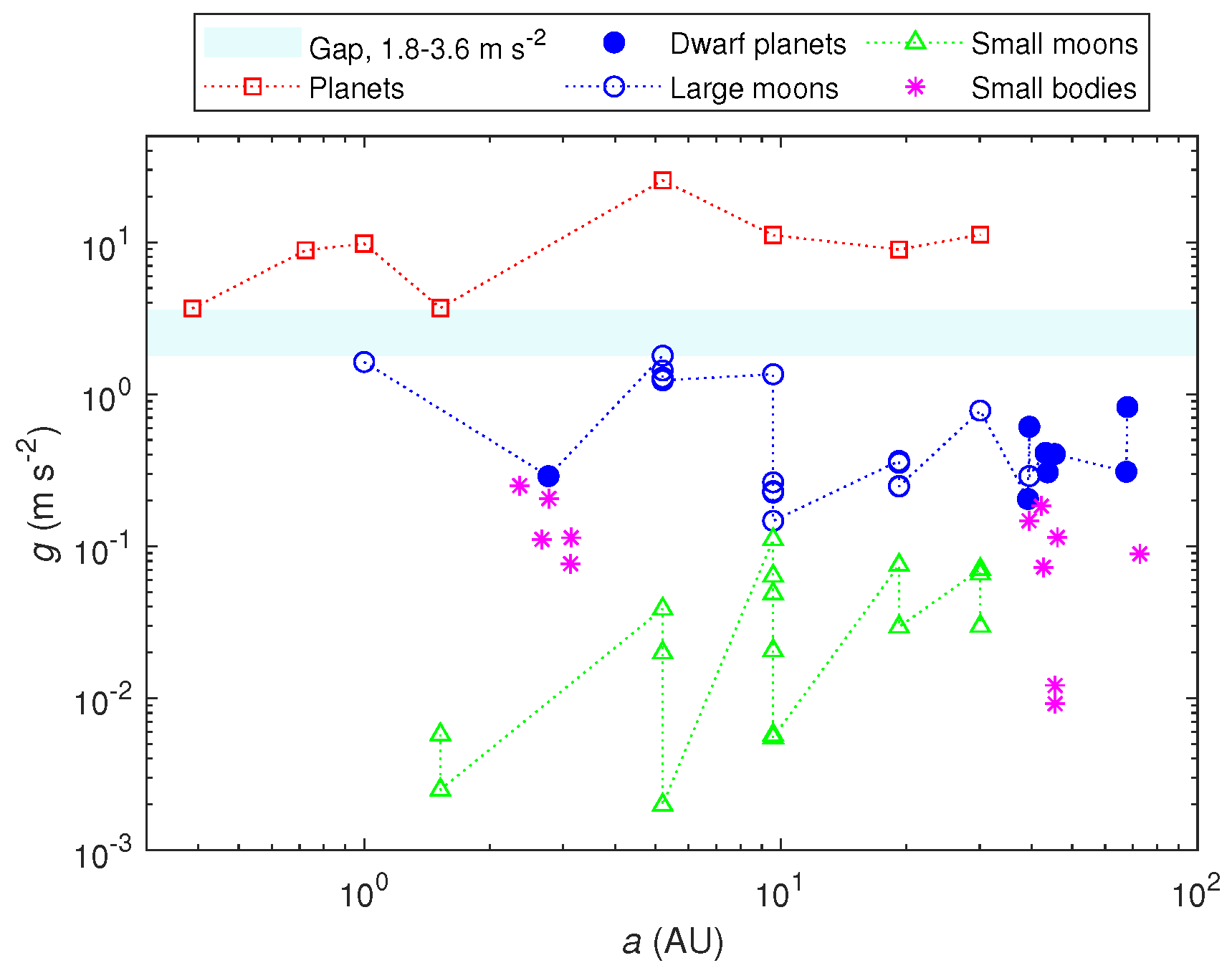
3.2. Brief Digression to Exoplanets
3.3. Dwarf planets in our solar system, a partial definition
4. Mean Diameters of Dwarf Planets and Satellites
4.1. Dwarf Planets Revisited
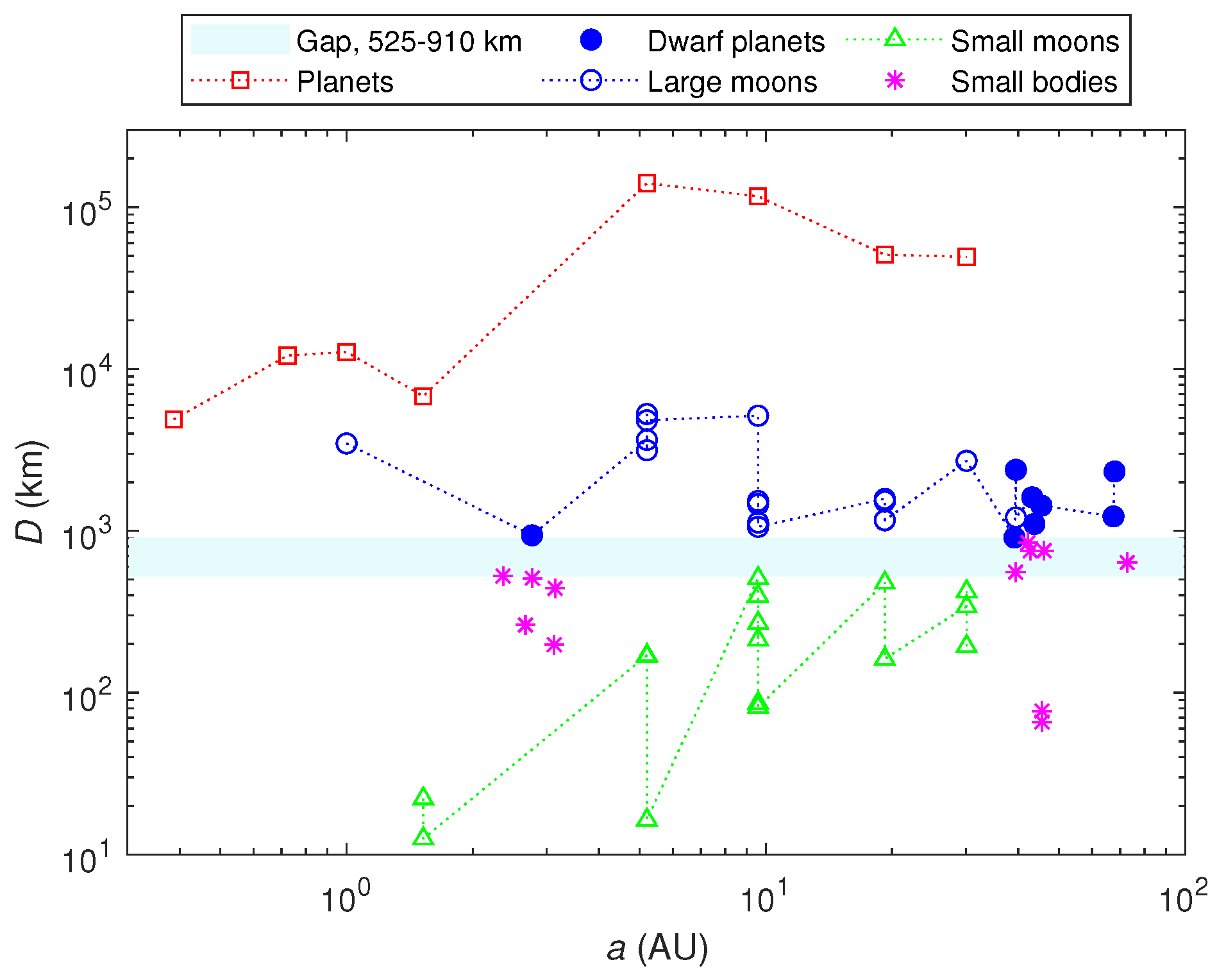
4.2. Large versus Small Satellites
4.3. A Resolute Alternative View
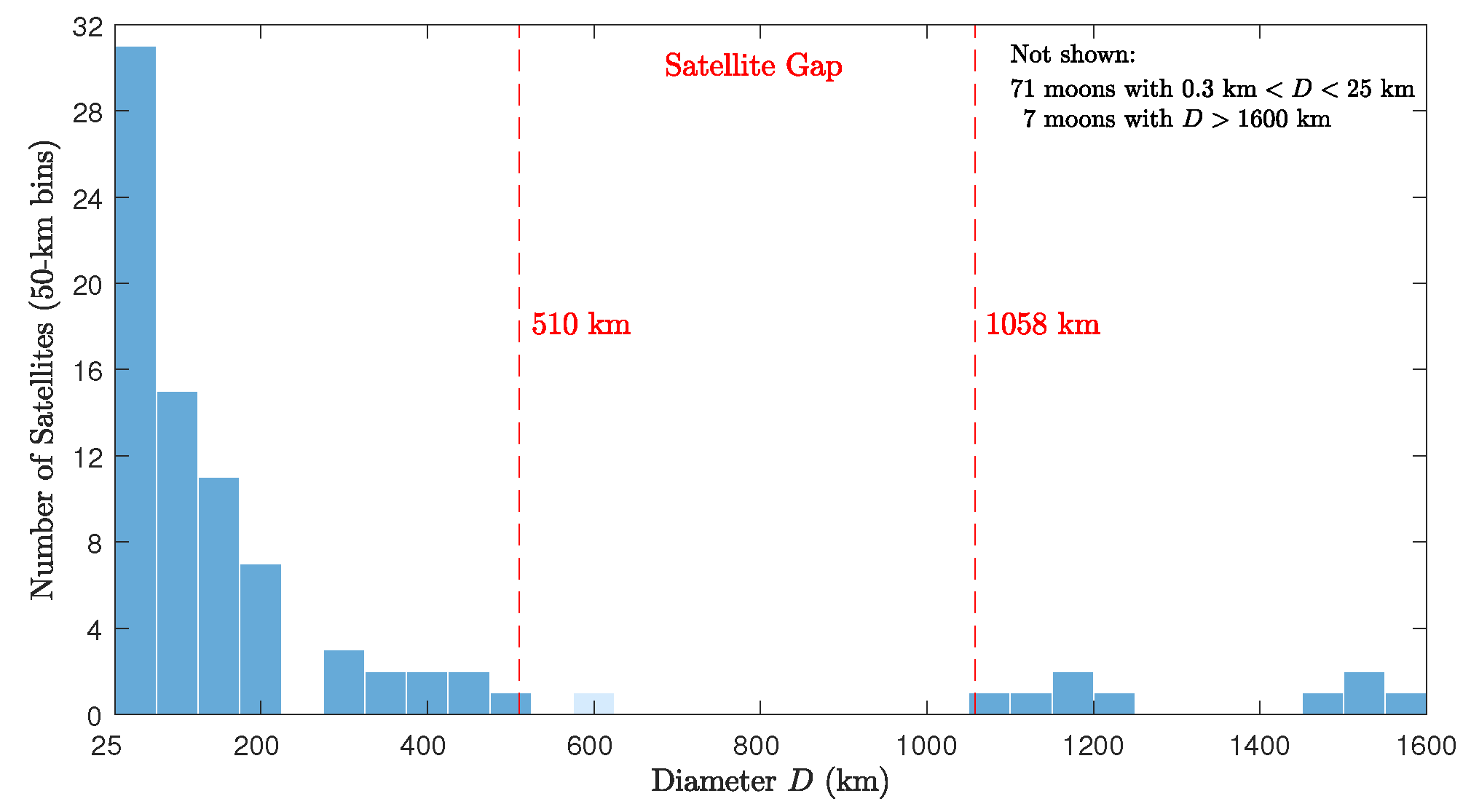
5. Masses of Planets and Satellites
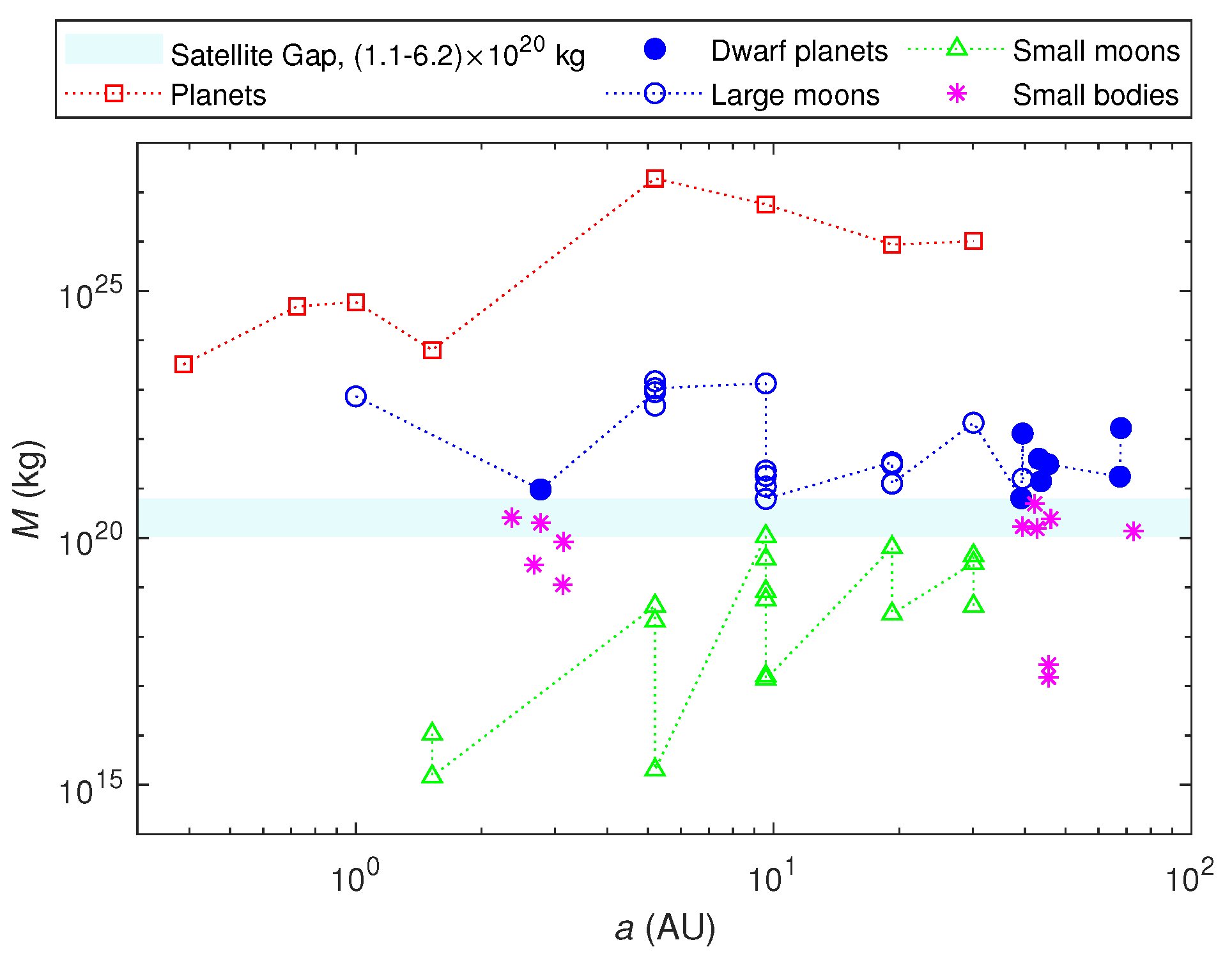
6. Summary and Concluding Remarks
6.1. Summary
- (1)
- Planets are differentiated from all other objects by their large surface gravities ( m s−2). There is no need to refer to any orbital characteristic or any additional physical property. This is a surprising result: Definition 2 in Section 3.1 can identify a planet without any reference to the object’s orbital state or environment (and it seems to work for extreme exoplanets too; see Section 3.2). This is also affirmation of a general principle that we have espoused long ago—gravity, and only gravity, has the final word in the formation of satellites, planets, and other objects grown to solar-system scales; internal pressure or mechanical stresses are only resisting to the bitter end.
- (2)
- Large satellites are differentiated from small satellites by their sizes and masses, but not by their surface gravities or volume densities. This result is sensible since gravity is no longer dominant at smaller scales. The size and mass gaps are so wide (Figure 3 and Figure 5) that the results suggest strongly a division between all large and small objects in the solar system at a critical diameter of -1,000 km and a critical mass of - kg (Section 4 and Section 5, respectively).
- (3)
- Dwarf planets certainly have m s−2 but we also need to make use of additional, higher-order qualifiers such as thresholds in size and/or density. A size threshold is suggested by the strongly segregated satellites (Figure 4): km or 1,000 km—a subjective choice (see Section 4). A density threshold is provided for KBOs by the work of Grundy et al. [26], who relied on sizes, volume densities, and albedos to suggest on physical grounds that km and g cm−3 are likely objective thresholds. On the other hand, the definitions adopted by the IAU in 2006 are matched only if a critical diameter of 900 km is adopted—otherwise (for km), Ceres, Orcus, and some other nascent dwarfs will have to be demoted to the class of small solar-system bodies.
- (4)
- Main-belt asteroids are all excluded from the dwarf class for a choice of km (Section 4.3). Otherwise (for km), Ceres is the only asteroid that belongs to the dwarf class (Section 4.1).
- (5)
- KBOs are almost continuously distributed in size, and they can only be separated into small and large objects by the critical diameter determined from satellites (the two groups commingle in the figures). There is however an apparent gap in diameters between 756 and 1041 km in which only three mid-sized KBOs are found (Orcus, 2002 MS4, and Salacia). Depending on the choice of critical diameter, the dwarf class may end up with 7 or 11 members. If km is adopted and volume density [26] is used as a tertiary qualifier (Section 4.3), then the class will contain only seven dwarfs, all in the Kuiper belt: in order of increasing distance from the sun, these are Pluto, Haumea, Quaoar, Makemake, Gonggong, Eris, and Sedna.
- (6)
- Surface gravity g turned out to be the most important physical quantity for groups containing large objects (Section 3.1) in the classification scheme that we described. Looking at the g-data altogether, we can offer a general partition of classes of large objects in the solar system that will never have to be revised (we believe that all large objects have already been discovered) and it is also aesthetically pleasing: in metric units (m s−2), planets have ; satellites have ; and dwarf planets have . (The precise thresholds are (g-gap average), 1.8 (Io), and 0.82 (Eris), respectively.)
- (7)
- We have also determined a threshold for surface gravities of small objects ( g cm−3) from the clear division of sizes and masses between small and large satellites (Section 5). But the condition could only be a tertiary indicator of smallness after size and mass. In the case of KBOs, this higher-order threshold and the critical density of g cm−3 [26] allow for three mid-sized objects (Orcus, Salacia, and 2002 XV93) to be placed in the dwarf class. Between them, 2002 XV93 has the lowest surface gravity m s−2 and Salacia has the lowest volume density -1.5 g cm−3 [45,54].
- (8)
- Calculations based on the large surface-gravity gap and the large mass gap just below the major planets (i.e., just below Mercury) produce theoretical thresholds (secondary indicators) of mass and size above which an object should likely qualify as a planet (equations (8) and (9) in Section 5). The critical mass is 73% of Mercury’s mass, but the critical radius is only 4 km smaller than Mercury’s mean radius of km [50]. So, this threshold does not leave any room for planets smaller than Mercury in our solar system and perhaps beyond (Table 1 and Section 3.2). Such a lower limit in size for major planets has been discussed in the past (by all standards, Mercury is a singularly small planet), but the viewpoint had not been met with strong quantitative support until now (Section 5).
6.2. Concluding Remarks
6.2.1. Physical Properties (as Opposed to Orbital Properties)
6.2.2. Exoplanets
6.2.3. Our Moon and Io
Author Contributions
Funding
Data Availability Statement
Acknowledgments
Conflicts of Interest
Abbreviations
| 1 | Ptolemy’s Almagest, 1998, Translated and annotated by G. J. Toomer, Princeton Univ. Press, Princeton. |
| 2 | |
| 3 | |
| 4 | |
| 5 | |
| 6 | |
| 7 | |
| 8 | A triaxial ellipsoid with 266.0×205.4) km3 [17] and degree of triaxiality . |
| 9 | |
| 10 | |
| 11 | Adrastea’s shape has been called “irregular” [18], although we actually see a triaxial ellipsoid measuring 16×14) km3 with a mild degree of triaxiality . |
| 12 | Footnote 6 and en.wikipedia.org/wiki/Solar_System
|
| 13 | |
| 14 | |
| 15 | Ref. [27]. |
| 16 | |
| 17 | Ref. [30]. |
| 18 | |
| 19 | The concept of “dynamical dominance,” an extrinsic property, has recently gained traction [3,6,7]. From our point of view, such classification criteria are not necessary since the dominance of a self-gravitating body is manifested, above all, by the strength of its surface gravity; and it diminishes as we move out and into the body’s neighborhood. |
| 20 | This is a subjective choice that we make in this work, bowing to the majority that wants Ceres and Orcus in the dwarf class. We discuss an alternative view in Section 4.3 below. |
| 21 |
en.wikipedia.org/wiki/List_of_Solar_System_objects and Ref. [28]. |
| 22 | We note that 2002 XV93 is excluded by size ( km), not by density ( g cm−3). |
| 23 | Eris’ moon Dysnomia, with km and a very low albedo of [46], is not included in our meta-analysis because it is possible that the reported estimates could be inaccurate; see also recent work in Ref. [47], where km and . At any rate, Dysnomia (the lightly colored bin in Figure 4 below) may shrink the satellite size gap of -1058 km, but it does not affect the choice of . |
| 24 | For instance, there is a large gap of width km between the diameters of Jupiter’s Io and Callisto, viz. km, without any moons present. Thus, it seems that there was not enough material anywhere in the protosatellite accretion disks for a moon of that size to be formed. |
| 25 | There is an analogous gap in the distribution of KBOs between 756 and 1041 km that contains only three objects [28]. This is hardly surprising since objects with km have been observed so far in the Kuiper belt [28], and only 68 of them (3%) have km. As in Figure 4 for large moons, nature was prevented from assembling but a few large KBOs. |
| 26 | We are aware of three KBOs with km that have : Orcus, Salacia, and 2002 XV93. |
| 27 | The planets of the Kepler-51 system (Table 1) show that object mass alone fails as a primary qualifier, but surface gravity succeeds in a difficult case involving extrasolar bodies with extreme properties. |
| 28 | NASA Exoplanet Archive, exoplanetarchive.ipac.caltech.edu
|
| 29 | Even if the Moon had been made from a larger mass such as that of Io, and if gravity had managed to push the contraction down to the present size of the Moon (which we seriously doubt), then g would still be slightly lower than 2 m s−2. |
References
- Stern, S. A.; Levison, H. F. Regarding the criteria for planethood and proposed classification schemes. Highlights Astron 2002, 12, 205. [Google Scholar] [CrossRef]
- Czechowski, L. Planetology and classification of the solar system bodies. Adv. Space Res. 2006, 38, 2054. [Google Scholar] [CrossRef]
- Soter, S. What is a planet? Astron. J. 2006, 132, 2513. [Google Scholar] [CrossRef]
- Tancredi, G.; Favre, S. Which are the dwarfs in the solar system? Icarus 2008, 195, 851. [Google Scholar] [CrossRef]
- Tancredi, G. Physical and dynamical characteristics of icy `dwarf planets’ (plutoids), Proc. IAU Symposium no. S263, vol. 5, Eds. J. A. Fernández et al.; Cambridge University Press: Cambridge, 2009; p. 173. [Google Scholar]
- Margot, J.-L. A quantitative criterion for defining planets. Astron. J. 2015, 150, 185. [Google Scholar] [CrossRef]
- Margot, J.-L.; Gladman, B.; Yang, T. Quantitative criteria for defining planets. Planet. Sci. J. 2024, 5, 159. [Google Scholar] [CrossRef]
- McIntyre, S. R. N.; King, P. L.; Mills, F. P. A rocky exoplanet classification method and its application to calculating surface pressure and surface temperature. Mon. Not. R. Astron. Soc. 2023, 519, 6221. [Google Scholar] [CrossRef]
- Dick, S. J. Discovery and classification in Astronomy: Scientific and philosophical challenges and the importance of a comprehensive and consistent classification system. Planet. Sci. J. 2024, 5, 139. [Google Scholar] [CrossRef]
- Heath, T. A History of Greek Mathematics; Clarendon Press: Oxford, 1921. [Google Scholar]
- Lawson, R. M. Science in the Ancient World: An Encyclopedia; ABC-CLIO: Santa Barbara, 2004. [Google Scholar]
- Dijksterhuis, E. J. The mechanization of the world picture (Translated by C. Dikshoorn); Princeton Univ. Press: Princeton, 1969. [Google Scholar]
- Greene, N. Aristarchus of Samos: An Ancient Philosopher with Modern Ideas, ThoughtCo, Jun. 4, 2018. 2018. Available online: www.thoughtco.com/aristarchus-of-samos-3072223.
- Heath, T. Aristarchus of Samos, the ancient Copernicus; Oxford Univ. Press: London, 1913. [Google Scholar]
- Spyrou, N. K. Aristarchos of Samos: Founder of Astronomy. 2010. Available online: www.astro.auth.gr/esa/Aristarchos%20of%20Samos_%20Spyrou_June10/ARISTARCHOS-ATV%204-%20Justification.pdf.
- Heath, T. L. The works of Archimedes; Cambridge Univ. Press: Cambridge, 1897. [Google Scholar]
- Thomas, P. C. Sizes, shapes, and derived properties of the saturnian satellites after the Cassini nominal mission. Icarus 2010, 208, 395. [Google Scholar] [CrossRef]
- Thomas, P. C.; Burns, J. A.; Rossier, L.; et al. The small inner satellites of Jupiter. Icarus 1998, 135, 360. [Google Scholar] [CrossRef]
- Chandrasekhar, S. Ellipsoidal figures of equilibrium; Yale Univ. Press: New Haven, 1969. [Google Scholar]
- Basri, G.; Brown, M. E. Planetesimals to brown dwarfs: what is a planet? Ann. Rev. Earth Planet. Sci. 2006, 34, 193. [Google Scholar] [CrossRef]
- Brown, M. E. Thoughts on the planet debate. 2006. Available online: https://web.gps.caltech.edu/ mbrown/whatsaplanet.
- Kazanas, D. Alternatives to dark matter. AIP Conf. Proc. 1995, 336, 495. [Google Scholar]
- Christodoulou, D. M.; Kazanas, D. Gauss’s law and the source for Poisson’s equation in modified gravity with varying G. Mon. Not. R. Astron. Soc. 2019, 484, 1421. [Google Scholar] [CrossRef]
- Christodoulou, D. M.; Kazanas, D. Varying-G gravity: physical properties, asymptotic regimes and Green’s functions, an event horizon, the vacuum energy density, and the external pressure that modifies Jeans stability. Mon. Not. R. Astron. Soc. 2023, 519, 1277. [Google Scholar] [CrossRef]
- Gauch, H. G. Scientific method in practice; Cambridge University Press: Cambridge, 2003. [Google Scholar]
- Grundy, W. M.; Noll, K. S.; Buie, M. W.; et al. The mutual orbit, mass, and density of transneptunian binary G!kún‖’hòmdímà (229762 2007 UK126). Icarus 2297, 334, 30. [Google Scholar] [CrossRef]
- Mommert, M.; Harris, A. W.; Kiss, C.; et al. TNOs are cool: A survey of the trans-Neptunian region, V. Physical characterization of 18 plutinos using Herschel-PACS observations. Astron. Astrophys. 2012, 541, A93. [Google Scholar] [CrossRef]
- Brown, M. E. How many dwarf planets are there in the outer solar system? 2020. Available online: https://web.gps.caltech.edu/ mbrown/dps.html.
- Lacerda, P.; Jewitt, D. C. Densities of solar system objects from their rotational light curves. Astron. J. 2007, 133, 1393. [Google Scholar] [CrossRef]
- Grundy, W. M.; Porter, S. B.; Benecchi, S. D.; et al. The mutual orbit, mass, and density of the large transneptunian binary system Varda and Ilmarë. Icarus 2015, 257, 130. [Google Scholar] [CrossRef]
- Ortiz, J. L.; Sicardy, B.; Camargo, J. I. B.; et al. Stellar occultations by transneptunian objects: from predictions to observations and prospects for the future. In The Transneptunian Solar System; Prialnik, D., et al., Eds.; Elsevier: Amsterdam, 2020; p. 413. [Google Scholar]
- Brit, R. R. Nine planets become 12 with controversial new definition. 2006. Available online: www.space.com/2741-planets-12-controversial-definition.html.
- Batygin, K.; Adams, F. C.; Brown, M. E.; Becker, J. C. The planet nine hypothesis. Phys. Rep. 2019, 805, 1. [Google Scholar] [CrossRef]
- Murray, C. D.; Dermott, S. F. Solar System Dynamics; Cambridge Univ. Press: Cambridge, 1999; p. 396. [Google Scholar]
- Christodoulou, D. M.; Laycock, S. G. T.; Kazanas, D. II. Laplace-like phase angles to facilitate libration searches in multiplanet N-body simulations. Astrophys. J. 2024. [Google Scholar]
- Grimm, S. L.; Demory, B.-O.; Gillon, M.; et al. The nature of the TRAPPIST-1 exoplanets. Astron. Astrophys. 2018, 613, A68. [Google Scholar] [CrossRef]
- Dittmann, J. A.; Irwin, J. M.; Charbonneau, D.; et al. A temperate rocky super-Earth transiting a nearby cool star. Nature 2017, 544, 333. [Google Scholar] [CrossRef]
- Masuda, K. Very low density planets around Kepler-51 revealed with transit timing variations and an anomaly similar to a planet-planet eclipse event. Astrophys. J. 2014, 783, 53. [Google Scholar] [CrossRef]
- Libby-Roberts, J. E.; Berta-Thompson, Z. K.; Désert, J.-M.; et al. The featureless transmission spectra of two super-puff planets. Astron. J. 2020, 159, 57. [Google Scholar] [CrossRef]
- Orosz, J. A.; Welsh, W. F.; Carter, J. A.; et al. Kepler-47: A transiting circumbinary multiplanet system. Science 2012, 337, 1511. [Google Scholar] [CrossRef]
- Judkovsky, Y.; Ofir, A.; Aharonson, O. Kepler multitransiting system physical properties and impact parameter variations. Astron. J. 2024, 167, 103. [Google Scholar] [CrossRef]
- Vanderburg, A.; Rowden, P.; Bryson, S.; et al. A habitable-zone Earth-sized planet rescued from false positive status. Astrophys. J. 2020, 893, L27. [Google Scholar] [CrossRef]
- Weiss, L. M.; Marcy, G. W. The mass-radius relation for 65 exoplanets smaller than 4 Earth radii. Astrophys. J. 2014, 783, L6. [Google Scholar] [CrossRef]
- Rommel, F. L.; Braga-Ribas, F.; Ortiz, J. L.; et al. A large topographic feature on the surface of the trans-Neptunian object (307261) 2002 MS4 measured from stellar occultations. Astron. Astrophys. 2023, 678, A167. [Google Scholar] [CrossRef]
- Brown, M. E.; Butler, B. J. The density of mid-sized Kuiper Belt objects from ALMA thermal observations. Astron. J. 2017, 154, 19. [Google Scholar] [CrossRef]
- Brown, M. E.; Butler, B. J. Medium-sized satellites of large Kuiper belt objects. Astron. J. 2018, 156, 164. [Google Scholar] [CrossRef]
- Brown, M. E.; Butler, B. J. Masses and densities of dwarf planet satellites measured with ALMA. Planet. Sci. J. 2023, 4, 193. [Google Scholar] [CrossRef]
- Boss, A. P. Giant planet formation by gravitational instability. Science 1997, 276, 1836. [Google Scholar] [CrossRef]
- Rommel, F. L.; Braga-Ribas, F.; Desmars, J.; et al. Stellar occultations enable milliarcsecond astrometry for Trans-Neptunian objects and Centaurs. Astron. Astrophys. 2020, 644, A40. [Google Scholar] [CrossRef]
- Seidelmann, P. K.; Archinal, B. A.; A’hearn, M. F.; et al. Report of the IAU/IAG Working Group on cartographic coordinates and rotational elements: 2006. Cel. Mech. Dyn. Astron. 2007, 98, 155. [Google Scholar] [CrossRef]
- Nimmo, F.; Umurhan, O.; Lisse, C. M.; et al. Mean radius and shape of Pluto and Charon from New Horizons images. Icarus 2017, 287, 12. [Google Scholar] [CrossRef]
- Stern, S. A.; Grundy, W. M.; McKinnon, W. B.; et al. The Pluto system after New Horizons. Ann. Rev. Astron. Astrophys. 2018, 56, 357. [Google Scholar] [CrossRef]
- Thomas, P. C.; Davies, M. E.; Colvin, T. R.; et al. The shape of Io from Galileo limb measurements. Icarus 1998, 135, 175. [Google Scholar] [CrossRef]
- Grundy, W. M.; Noll, K. S.; Roe, H. G.; et al. Mutual orbit orientations of transneptunian binaries. Icarus 2019, 334, 62. [Google Scholar] [CrossRef]
- Drake, S. Galileo At Work: His Scientific Biography; Univ. of Chicago Press: Chicago, 1978. [Google Scholar]
- Vanderburg, A.; Becker, J. C.; Kristiansen, M. H.; et al. Five planets transiting a ninth magnitude star. Astophys. J. Lett. 2016, 827, L10. [Google Scholar] [CrossRef]
- Berardo, D.; Crossfield, I. J. M.; Werner, M.; et al. Revisiting the HIP41378 system with K2 and Spitzer. Astron. J. 2019, 157, 185. [Google Scholar] [CrossRef]
- Lopez, T. A.; Barros, S. C. C.; Santerne, A.; et al. Exoplanet characterisation in the longest known resonant chain: the K2-138 system seen by HARPS. Astron. Astrophys. 2019, 631, A90. [Google Scholar] [CrossRef]
- Hardegree-Ullman, K. K.; Christiansen, J. L., Ciardi; et al. K2-138 g: Spitzer spots a sixth planet for the Citizen Science System. Astron. J. 2021, 161, 219. [Google Scholar] [CrossRef]
- Borucki, W. J.; Koch, D. G., Basri; et al. Characteristics of planetary candidates observed by Kepler. II. Analysis of the first four months of data. Astrophys. J. 2011, 736, 19. [Google Scholar] [CrossRef]
- Mills, S. M.; Fabrycky, D. C.; Migaszewski, C.; et al. A resonant chain of four transiting, sub-Neptune planets. Nature 2016, 533, 509. [Google Scholar] [CrossRef]
- Mills, S. M.; Fabrycky, D. C. Mass, density, and formation constraints in the compact, sub-Earth Kepler-444 system including two Mars-mass planets. Astrophys. J. Lett. 2017, 838, L11. [Google Scholar] [CrossRef]
- Weiss, L. M.; Isaacson, H.; Howard, A. W.; et al. The Kepler giant planet search. I. A decade of Kepler planet-host radial velocities from W. M. Keck Observatory. Astrophys. J. Suppl. Ser. 2024, 270, 8. [Google Scholar] [CrossRef]
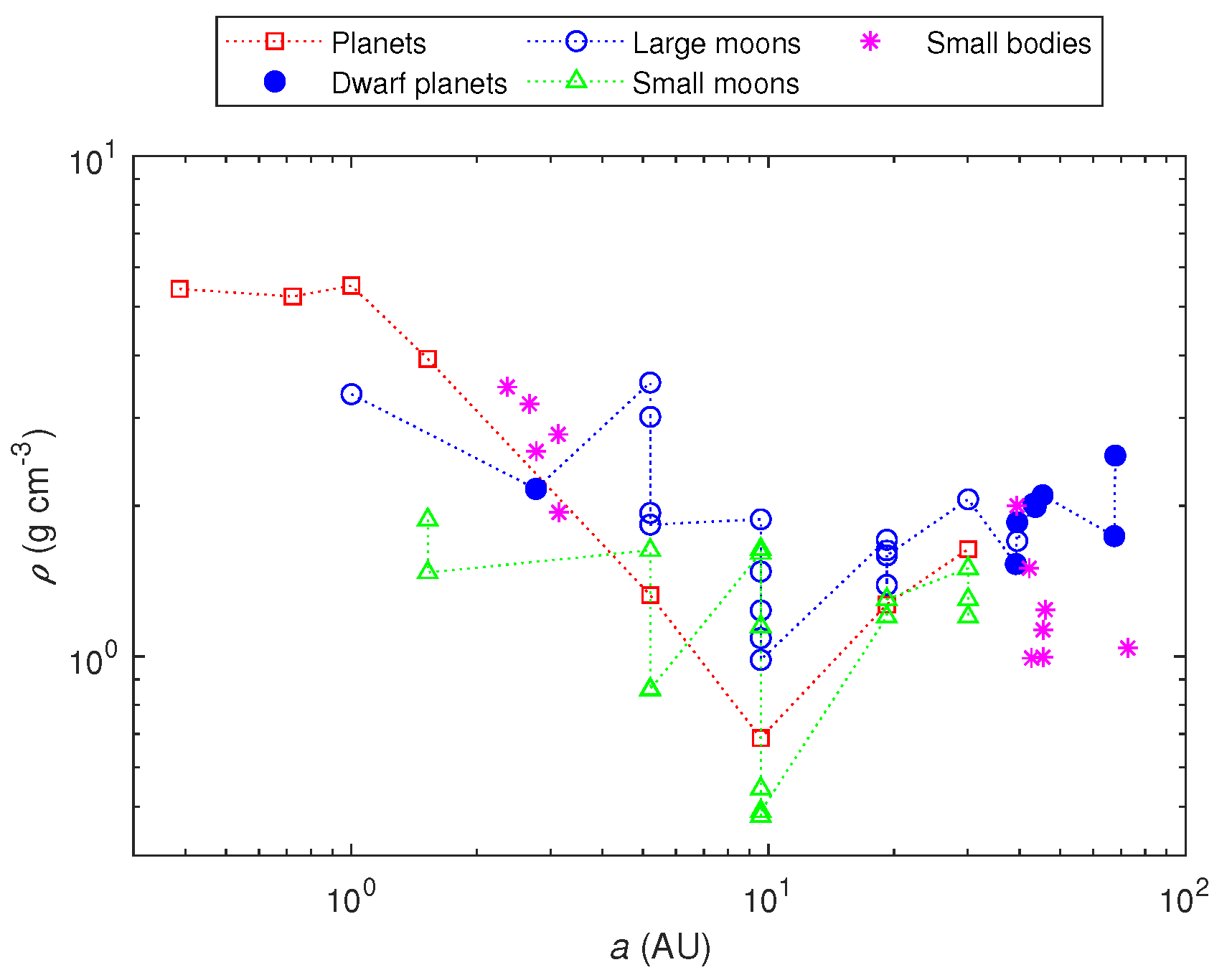
| Object | E/D | Ref. | a | M | D | g | Classification | |
|---|---|---|---|---|---|---|---|---|
| Name | Properties | (AU) | (g cm−3) | (kg) | (km) | (m s−2) | (this paper) | |
| TRAPPIST-1 b | (a) | (1) | 0.0115 | 3.99 | 7.97 | P | ||
| TRAPPIST-1 c | (a) | (1) | 0.0158 | 4.79 | 9.39 | P | ||
| TRAPPIST-1 d | (a) | (1) | 0.0223 | 3.36 | 4.71 | P | ||
| TRAPPIST-1 e | (a) | (1) | 0.0293 | 5.63 | 9.13 | P | ||
| TRAPPIST-1 f | (a) | (1) | 0.0370 | 4.56 | 8.46 | P | ||
| TRAPPIST-1 g | (a) | (1) | 0.0469 | 4.16 | 8.52 | P | ||
| TRAPPIST-1 h | (a) | (1) | 0.0619 | 3.95 | 5.44 | P | ||
| LHS 1140 b | (a) | (2) | 0.0875 | 12.5 | 31.9 | P | ||
| Kepler-51 b | (b) | (3) | 0.247 | 0.064 | 0.76 | DP | ||
| Kepler-51 c | (b) | (3) | 0.377 | 0.034 | 0.54 | DP | ||
| Kepler-51 d | (b) | (3) | 0.500 | 0.048 | 0.62 | DP | ||
| Kepler-47 b | (c) | (4) | 0.296 | 1.67 | 9.01 | P | ||
| Kepler-176 b | (d) | (5) | 0.05723 | 21.3 | 50.7 | P | ||
| Kepler-176 c | (d) | (5) | 0.1011 | 2.03 | 8.32 | P | ||
| Kepler-176 d | (d) | (5) | 0.1615 | 1.77 | 7.68 | P | ||
| Kepler-176 e | (d) | (5) | 0.2552 | 0.444 | 1.08 | DP | ||
| WD 1145+017 b | (e) | (6) | 0.005 | 1.09 | 0.29 | DP | ||
| GQ Lup b | (f) | (7) | 103 | 4.89 | 172 | P (or BD) | ||
| Kepler-1649 c | (g) | (8) | 0.0827 | 5.79 | 10.9 | P |
| Object | a | M | R | g | Refs. |
|---|---|---|---|---|---|
| Name | (AU) | () | () | (m s−2) | |
| HIP 41378 f | 1.37 | 12 | 9.2 | 1.39 | [56,57] |
| K2-138 f | 0.1045 | 1.63 | 2.9 | 1.89 | [58,59] |
| Kepler-223 e | 0.1486 | 4.8 | 4.6 | 2.22 | [60,61] |
| Kepler-444 d | 0.0578 | 0.048 | 0.453 | 2.31 | [62,63] |
| Kepler-444 e | 0.0671 | 0.045 | 0.475 | 1.94 | [62,63] |
| Property | Ioa,b | Moon c | Moon/Io Ratio |
|---|---|---|---|
| g (m s−2) | 1.80 | 1.62 | 0.90 |
| D (km) | 3643 | 3475 | 0.95 |
| M ( kg) | 8.93 | 7.35 | 0.82 |
| (g cm−3) | 3.528 | 3.344 | 0.95 |
| (km) | 421,800 | 384,400 | 0.91 |
| (deg) | 2.213 | 5.145 | 2.32 |
| e | 0.0041 | 0.055 | 13.4 |
Disclaimer/Publisher’s Note: The statements, opinions and data contained in all publications are solely those of the individual author(s) and contributor(s) and not of MDPI and/or the editor(s). MDPI and/or the editor(s) disclaim responsibility for any injury to people or property resulting from any ideas, methods, instructions or products referred to in the content. |
© 2024 by the authors. Licensee MDPI, Basel, Switzerland. This article is an open access article distributed under the terms and conditions of the Creative Commons Attribution (CC BY) license (http://creativecommons.org/licenses/by/4.0/).





